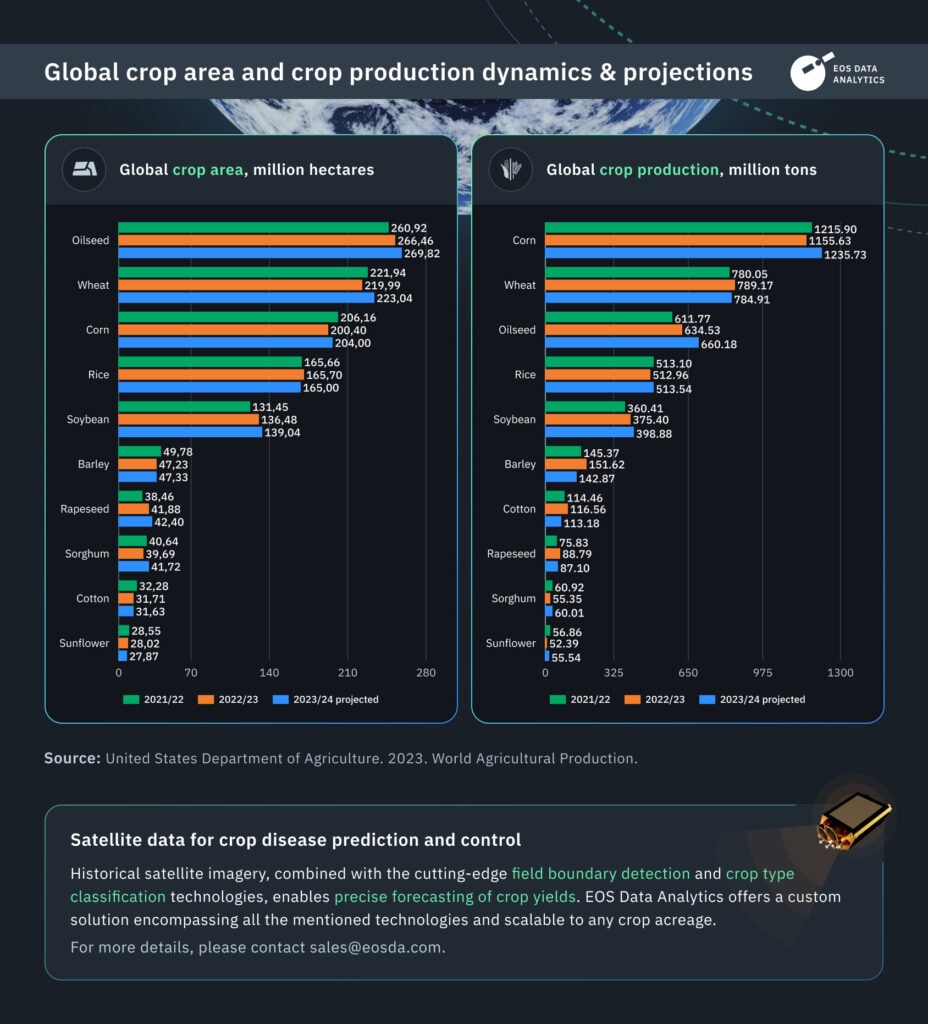Agriculture is the primary food production sector. As the basic human need for food grows apace with the global population, the industry is bound to evolve to meet the most vital demand.
This, however, presents a significant challenge, given the complex network of interconnected processes agriculture is influenced by, including the ever-changing weather patterns attributed to climate change. Building a climate-resilient food system that relies on innovative agricultural solutions and employs sustainable practices is increasingly seen as a shortcut to achieving sustained agricultural productivity growth on a global scale. In this article, we’ll explore the world’s major crop commodities and agricultural powerhouses – the largest staple crop producers acting as a backbone of our food safety.
Prospects for Key Crop Commodities
The 2023-2032 Agricultural Outlook released by FAO and OECD projects that global agri-food production will continue to grow at an average of 1.1% per year – a twice slower rate than in the previous decade. The slowdown is attributed to geopolitical tensions, adverse climate trends, and volatile prices for major agricultural inputs.
As per capita cereals consumption is close to being well-met in many world countries, the report projects a decrease in demand for cereals production growth by 2032. Innovative plant breeding and more intensive production systems are predicted to be key drivers of crop production growth globally. That said, yield improvements (79%) are expected to contribute the most to increased agricultural output, followed by crop area expansion (15%).
Productivity-Enhancing Precision Agriculture Solutions
As already mentioned, innovative agriculture solutions play a pivotal role as far as strategies for sustainable crop productivity growth are concerned. Driven by advances in satellite-powered Earth observations and AI, a host of game-changing Ag Tech services have emerged to assist crop producers in monitoring, managing, and enhancing the production potential of their land.
Leveraging diverse data and sophisticated ML algorithms powers the development of digital solutions for agriculture delivering critically important analytics with over 90% accuracy, including scalable pre-season yield predictions for improved crop management, crop classification maps providing insight into the agriculture market trends, and cross-season harvest dynamics reports for smarter post-harvesting planning.
Global Crop Area and Crop Production

Global food security largely depends on a surprisingly small group of cultivated plants known as staple crops. To better understand where the agricultural sector is headed, here’s an overview of the past seasons’ stats across 10 major food crops and projections for the next one.
In terms of global crop area, oilseed is projected to keep holding the lead in the 2023/24 season (269.8 million ha) closely followed by wheat (223 million ha) and corn (204 million ha). The smallest portions of croplands will be allotted to sorghum (31.6 million ha), cotton (31.6 million ha), and sunflower (27.8 million ha). Speaking of year-on-year trends, oilseed, corn, soybean, and rapeseed show a steady increase in the amount of sown hectares, while areas under cotton (32.28 vs 31.63 million ha) and sunflower (28.55 vs 27.87 million ha) are gradually declining. Overall, an upward trend is observed, which attests to the cropland expansion predicted by the 2023-2032 Agricultural Outlook.
Global crop production-wise, the following five staples will be feeding most of the world’s population in the next season:
Corn
Projected global production in 2023/24: 1235.73 million tons
Corn (maize) is the main staple bringing food to the tables of nearly a third of the global population, particularly in Sub-Saharan African countries. The U.S., China, and Brazil are the largest corn producers. Aside from food purposes, corn is also grown as livestock feed, and corn fiber is utilized for renewable fuel production. Cellulose extracted from corn husks gets a second life as biodegradable plastic.
Wheat
Projected global production in 2023/24: 784.91 million tons
China and India account for the largest share of wheat production – a cereal that is central to human nutrition due to its high nutritional value. An indispensable part of the diets of billions of people today, this crop has been a staple and highly valuable traded commodity for over 10,000 years. Nowadays, its pricing influences the global inflation rates.
Oilseed
Projected global production in 2023/24: 660.18 million tons
Asia-Pacific region (China, India) is the largest oilseed farming market, followed by North America (U.S. and Canada). Oilseed crops are mainly cultivated for oil extraction. Vegetable oils are used in cooking, food processing, biofuel production, and cosmetics; while the extraction leftovers constitute animal feed.
Rice
Projected global production in 2023/24: 513.54 million tons
Rice is the major staple food for half of the world’s population and a source of income for millions of subsistence farmers. Although this plant is grown on all continents except Antarctica, Asian countries (China, India, Bangladesh, Indonesia, Vietnam) are the major rice-producing areas whose landscapes are fraught with iconic terraced rice paddies. Rice is vital to food security through easy storage and long shelf life.
Soybean
Projected global production in 2023/24: 398.88 million tons
This leguminous plant proves indispensable in multiple scenarios: it serves as a protein source in people’s diets (tofu, soy milk), provides vegetable oils, and is used as an organic nitrogen fertilizer for agricultural soils. Soybean production hotspots are located in the U.S., Argentina, and Brazil.
The geography of global crop production is diverse, with different regions dominating the supply of various staples due to peculiar climates, economic, and cultural factors. Today, the largest crop-production countries are put at the forefront of ensuring that food supply meets demand, despite all the uncertainties getting in the way of steadily high yields. It is through the implementation of innovative agricultural solutions, sustainable farming practices, and with strong governmental support, that global agricultural productivity can receive a much-needed boost and provide the solution to agriculture’s most pressing challenge of feeding nearly 10 billion people by 2050.
